(An archive question of the week)
Last time we looked at various 2- and 3-set Venn diagram problems (and alternative methods). One discussion I found while collecting them deserved to be set aside for special examination, if only because it would scare the beginner. A mixture of tools will make the work easier.
Here it is, from 2003:
Derfs and Enajs: Algebra and Venn Diagrams All Derfs are Enajs. One-third of all Enajs are Derfs. Half of all Sivads are Enajs. One Sivad is a Derf. Eight Sivads are Enajs. The number of Enjas is 90. How many Enajs are neither Derfs nor Sivads?
In case you didn’t notice, the names are just Fred, Jane, and Davis, backward! It’s fun making up nonsense names; and they emphasize the abstract nature of such a problem — it could be about anything! But since they also serve to make the problem look more confusing, we can often reduce the names to abbreviations, D, E, and S to keep things simple.
But what do we do with such a load of information? We organize it, of course! Doctor Greenie took it:
There are two basic approaches to a problem like this. One is purely algebraic: we write a series of equations based on the given information and try to solve that set of equations. The other is a visual process using Venn diagrams. I usually find the visual approach easier to use, but sometimes for a complex problem I resort to an algebraic approach. And sometimes using a combination of the two helps to keep track of what I am doing towards solving the problem. So let's set up both the algebraic and visual approaches to this problem and see how we can use both of them to solve your particular problem. For the visual approach, we use a Venn diagram, consisting of three mutually intersecting circles that represent the Enajs, Derfs, and Sivads.
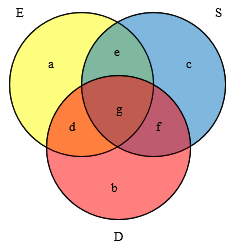
The "E" circle represents all the Enajs; the "D" circle represents all the Derfs; and the "S" circle represents all the Sivads. These boxes all intersect, giving us seven regions, which I have labeled with lower-case letters as follows: a: Enaj yes; Derf no; Sivad no b: Enaj no; Derf yes; Sivad no c: Enaj no; Derf no; Sivad yes d: Enaj yes; Derf yes; Sivad no e: Enaj yes; Derf no; Sivad yes f: Enaj no; Derf yes; Sivad yes g: Enaj yes; Derf yes; Sivad yes For example, the region labeled "e" is inside the "E" and "S" boxes but outside the "D" box; so any element in this region is both an Enaj and a Sivad but is not a Derf.
In the original, the circles are rough boxes, which made it awkward to show his thinking graphically. I have redone the diagram as an image, and will add graphical ideas where he mentions them.
To set up the algebraic approach, I define variables to represent the numbers of elements that possess the different possible combinations of characteristics. I come up with a list identical to the preceding list: let a = number which are Enajs but not Derfs or Sivads let b = number which are Derfs but not Enajs or Sivads ... let g = number which are Enajs and Derfs and Sivads Now we are ready to solve the problem by using the given information both in the Venn diagram and in our algebraic approach. (1) All Derfs are Enajs In the Venn diagram, this means there are no elements in the "D" box that are outside the "E" box; so there are no elements in regions b or f. Algebraically, we have b=0 f=0
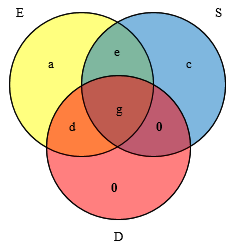
(2) One-third of all Enajs are Derfs We can't do a lot with this information just yet in our Venn diagram (I use it in step (1) below). This information tells us that the combined number of elements in regions d and g (the elements that are both Enajs and Derfs) is one-third the combined number of regions a, d, e, and g (the total number of Enajs). Algebraically, we have d+g = (a+d+e+g)/3 This piece of information is equivalent to saying that there are twice as many elements in regions a and e together as there are in regions d and g together; so the above algebraic equation is equivalent to the following: a+e = 2(d+g)
At this point in the combined approach, we have the Venn diagram with two 0’s, and this one equation.
(3) Half of all Sivads are Enajs Again, we can't do a lot with this information just yet in our Venn diagram; this information tells us that the combined number of elements in regions e and g (the elements that are both Enajs and Sivads) is one-half the combined number of regions c, e, f, and g (the total number of Sivads). Algebraically, we have e+g = (c+e+f+g)/2 This piece of information is equivalent to saying that there are as many elements in regions e and g together as there are in regions c and f together; so the above algebraic equation is equivalent to the following: c+f = e+g
So now we have a diagram and two equations.
(4) One Sivad is a Derf In the Venn diagram, this tells us that the combined number of elements in regions f and g is 1. Algebraically, we have f+g = 1 (5) Eight Sivads are Enajs In the Venn diagram, this tells us that the combined number of elements in regions e and g is 8. Algebraically, we have e+g = 8 (6) The number of Enajs is 90 In the Venn diagram, this information tells us that the combined number of elements in regions a, d, e, and g (representing all the Enajs) is 90. Algebraically, we have a+d+e+g = 90
These three facts, together with the zeros we put in above, let us fill in g = 1, e = 7, and E = 90:
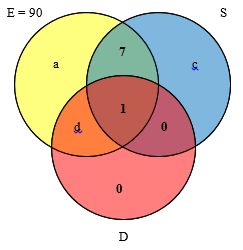
Doctor Greenie explains this:
Now we are ready to combine the pieces of information we have to find the numbers of elements in each region in the Venn diagram - i.e., to find the values of our algebraic variables a, b, c, d, e, f, and g. We currently have the following: (1) b = 0 and f = 0 (2) a+e = 2(d+g) (3) c+f = e+g (4) f+g = 1 (5) e+g = 8 (6) a+d+e+g = 90 Combining (1) and (4), we find (7) g = 1 (I am giving the explanation algebraically because it is easier in a typed explanation; in practice, I look at the Venn diagram and see there are no elements in region f and a total of 1 element in regions f and g together, so I conclude that there is 1 element in region g.) Then combining (5) and (7), we find (8) e = 7 (Again the given explanation is algebraic, but in practice I reach this conclusion by looking at my Venn diagram.) Next, combining (3) with (1), (7), and (8), we find (9) c = 8 The nature of the given information makes steps (7) through (9) above fairly obvious - they are conclusions which are easily drawn from the given information either algebraically or using the Venn diagrams.
In my diagram above, I had not yet put in c = 8, which comes from one of the equations (2 and 3) that did not directly go into the diagram. I will handle both equations below.
From this point on, however, there are various different paths to the final solution. The one that I think is easiest is apparent (to me) with the Venn diagram but rather difficult to see with the algebraic approach. So let me make my explanation using the Venn diagram instead of the algebraic approach. Item (6) tells me that the total number of Enajs is 90; item (2) tells me that there are twice as many Enajs that are NOT Derfs as there are Enajs that are Derfs. From this I conclude (10) a+e = 60 and d+g = 30 Then I finish the problem by combining (10) with (8) to get (11) a = 53 and by combining (10) with (7) to get (12) d = 29
I handle equation (2) visually by seeing that a + 7 must be 60 and d + 1 must be 30, and just doing the subtractions:
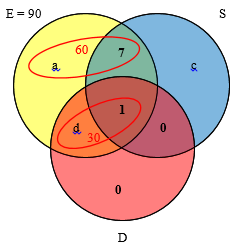
I handle equation (3) similarly (which Doctor Greenie already did above):
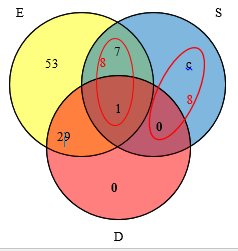
When I'm all done, as a check of the work I have done, I label each region of my Venn diagram with the numbers of elements I have determined for each region and go back and verify that those numbers fit all the given information. Again, I find this check easier to do using the Venn diagram than algebraically. And of course, having done all that work, we must remember to answer the question, which is, "How many Enajs are neither Derfs nor Sivads?" The answer is the number of elements in region a, which is 53.
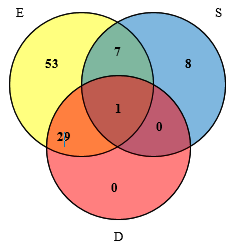
Not only is it easier to check using the diagram, I always recommend going back to the problem statement itself (not our equations), which confirms our interpretations:
All Derfs are Enajs. (Yes: there is nothing in D that is not also in E.)
One-third of all Enajs are Derfs. (Yes: there are 90 in E, of which 30 are also in D.)
Half of all Sivads are Enajs. (Yes: of 16 in S, 8 are also in E.)
One Sivad is a Derf. (Yes: only 1 is in the intersection of S and D.)
Eight Sivads are Enajs. (Yes: there are 8 in the intersection of S and E.)
The number of Enjas is 90. (Yes: the total in E is 90.)
How many Enajs are neither Derfs nor Sivads? (The yellow region holds 53.)
